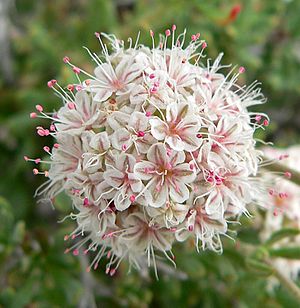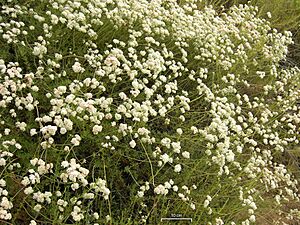California buckwheat facts for kids
Quick facts for kids California buckwheat |
|
|---|---|
 |
|
| Scientific classification | |
| Genus: |
Eriogonum
|
| Species: |
fasciculatum
|

Eriogonum fasciculatum is a type of wild buckwheat plant. It's usually called California buckwheat or eastern Mojave buckwheat. This plant is very common and important in many parts of the Southwestern United States.
Contents
Where California Buckwheat Grows
This common shrub grows naturally in the Southwestern United States, California, and northwestern Mexico. You can find it from the coasts of California and Baja California. It also grows inland through the Southern California Coast Ranges, Transverse Ranges, and Peninsular Ranges. You'll even see it further east in the Mojave Desert and Great Basin.
California buckwheat likes to grow on hillsides and in dry riverbeds. It lives in many different places, like chaparral (shrublands), coastal sage scrub, grasslands, and pine and juniper forests.
What California Buckwheat Looks Like
Eriogonum fasciculatum can look a bit different depending on where it grows. It can form a thick, compact bush or a wider plant that can reach up to 2 metres (6.6 ft) tall and 3 metres (9.8 ft) wide.
Its leaves grow in groups along the branches. They feel leathery and have a woolly texture on their undersides. The edges of the leaves are often rolled under.
The flowers grow in dense, fluffy clusters. These clusters can be anywhere from a few millimeters to 15 centimeters wide. Each tiny flower is pink and white, only a few millimeters across.
Different Types of California Buckwheat
There are several distinct types, or varieties, of California buckwheat. These include:
- Eriogonum fasciculatum var. emphereium—found only in western El Vizcaíno Biosphere Reserve
- Eriogonum fasciculatum var. fasciculatum
- Eriogonum fasciculatum var. flavoviride—also known as eastern Mojave buckwheat.
- Eriogonum fasciculatum var. foliolosum—called red topped buckwheat.
- Eriogonum fasciculatum var. polifolium
How People and Animals Use California Buckwheat
Used by People
California buckwheat has been an important plant for many Native American tribes. They used it for both food and traditional remedies.
Some tribes would make tea from the leaves, stems, and roots. Other tribes used the seeds. They would eat the seeds raw or use them to make porridges and baked goods.
The Tongva people, who call the plant wilakal, would gather the leaves before the plant flowered. They used these leaves to make a strong, thick tea. They also ground the dried roots to help with headaches and stomach problems.
This plant was widely used as a traditional medicinal plant by Native Americans. It helped with various health issues, including headaches, upset stomachs, and minor injuries. The Zuni people would make a poultice (a soft, moist mass) from the powdered root. They applied this to cuts and wounds. A special liquid made from the root was also taken after childbirth to help with healing. This same liquid was also used for hoarseness and colds that affected the throat.
Used by Wildlife
California buckwheat is a very important source of nectar for many animals in California. It's especially popular with native bees and other pollinators. It provides a good source of nectar for many months, even in dry areas. It also attracts honey bees.
California buckwheat plants are a food source for the caterpillars of several butterflies. These include the Bernardino dotted-blue, lupine blue, Mormon metalmark, and Behr's metalmark. The nut-brown hairstreak butterfly is often seen on these plants when they are in full bloom. It is also a host plant for the Acmon blue, blue copper, Electra buckmoth, Gorgon copper, and western green hairstreak butterflies.

Growing California Buckwheat in Gardens
Eriogonum fasciculatum is grown as an ornamental plant in gardens. People plant it in native plant gardens, drought-friendly gardens, and wildlife gardens. It's also used in larger projects for natural landscaping and bringing back natural habitats.


